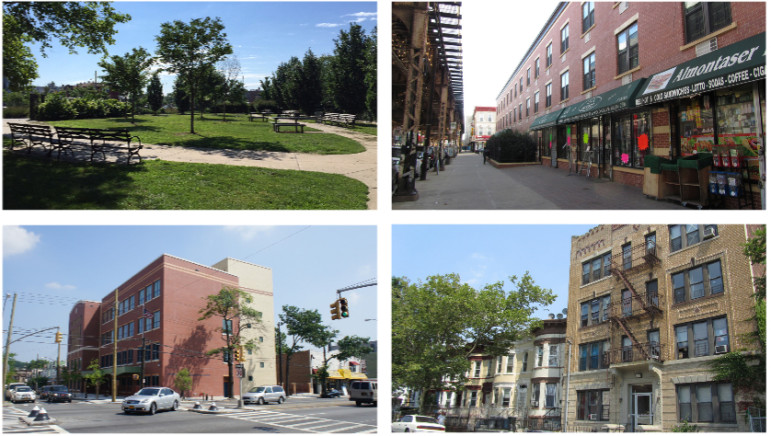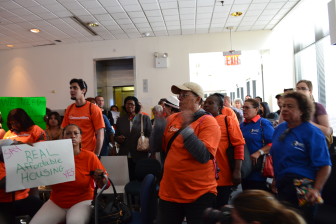
City Planning
Scenes from City Planning's briefing book on the East New York process.
On Monday, the Department of City Planning (DCP) commenced the review process for the rezoning of East New York —a major moment for the De Blasio administration’s affordable housing program.
East New York is the first of 15 neighborhoods targeted for a rezoning as part of the administration’s effort to build 80,000 and preserve 120,000 units of affordable housing. By rezoning corridors to promote residential and commercial development, the city seeks to encourage the growth of affordable housing while spurring neighborhood revitalization in areas regarded as underdeveloped.
All eyes are on East New York to judge the progress of the first neighborhood plan, and questions and concerns—about displacement, overcrowded schools, manufacturing zones and more—are already abounding.
With the launch of the Uniform Land Use Review Procedure (ULURP), the East New York Rezoning Proposal will go to multiple bodies over the next seven months for a vote, including the community boards of East New York and Ocean Hill, Brooklyn Borough President Eric Adams, the City Planning Commission and City Council.
At the City Planning Commission review session on Monday, Carl Weisbrod, DCP commissioner and chair of the planning commission, described the proposal as exemplifying “a new approach” to neighborhood planning.
“I think it underscores that we are a department of planning, not a department of zoning,” he said. “Zoning is not the only tool that is necessary for healthy neighborhoods. I think here, this is a big example of ground-up planning [and] working with the local community.”
The agency stressed the benefits that the plan would offer, including affordable housing, new jobs and new resources and streetscape improvements to enhance the neighborhood’s livability.
Yet many East New Yorkers continue to worry that the plan is a  [/caption]
[/caption]
But critics had hoped for more steps to protect industrial jobs, which pay better than retail work. Mixed Use Districts are ineffective at protecting industrial businesses, the Coalition says: Within the 15 mixed use districts mapped since 1997, there’s been a 71 percent increase in residential and commercial lot square footage and 41 percent loss of industrial lot square footage.
Yet DCP says the plan would be an economic boon for East New York, which suffers from a whopping 19 percent unemployment rate. The city says it will help East New Yorkers gain access to this employment by opening a Workforce 1 Center in the neighborhood, a top priority of the Coalition. The Department of Small Business Services is promising other help to neighborhood entrepreneurs.
Nevertheless, some East New Yorkers believe more can still be done to improve East New Yorker’s employment opportunities. The Coalition would like to see new developments required to set aside 25 percent of space for local businesses, at discounted rents. The Walmart Free NYC coalition, with Council member Rafael Espinal’s support, hopes to promote living wages, local hiring, stable scheduling, and other workers’ rights in the rezoning area by using a combination of incentives to developers and Community Benefits Agreements.
City acknowledges pressures
When DCP announced in July that the city would build a school in East New York with 1,000 seats, some East New Yorkers were not impressed. The new school would barely address existing overcrowding, they alleged, let alone accommodate the children of over 18,000 new residents.
The Draft Environmental Impact Statement released last week acknowledges the strain that development would place on neighborhood schools, which are organized into two subdistricts. According to the analysis, without the rezoning and increased population, one would still face a deficit of 650 elementary school seats in 2030. With the rezoning—including the construction of a new school—the subdistrict would face a deficit of 851 elementary school seats.
In the other subdistrict, there’d be little overcrowding without the rezoning. But the rezoning would cause the subdistrict to face a deficit of 761 elementary school seats and 404 middle school seats—and no new schools are yet planned for that area. DCP says it will explore a variety of options to mitigate overcrowding in this subdistrict, including reorganizing school space and building a new school.
The analysis also notes that development would exacerbate the area’s lack of park and recreation space. While the city recommends that there are 2.5 acres of open space for every 1,000 residents, the rezoning would cause the open space ratio to decline from .614 to .563 aces for every 1,000 residents. To mitigate this problem, the city says it is actively pursuing the creation of a new green space at City Line Park, improvements to Lower Highland Park, and the revitalization of Sperandeo Brothers Park.
The analysis also suggests that the increased population could negatively impact traffic and lead to overcrowding on the J/Z line and the Q8 bus. DCP says it will work with the Department of Transportation to improve streetscapes, and recommend the addition of a J/Z train and Q8 bus—a decision that ultimately lies with the New York City Transit Authority.
DCP did not agree with Coalition members that the increased population would place a stress on sewage infrastructure, libraries, and police precincts, and did not accept the Coalition’s proposal to designate East New York as a Density Growth Management Area, which would require developers to obtain certification that any development would be met with a sufficient increase in community facilities.
At Monday’s review session, members of the City Planning Commission also brought up their own questions and concerns. Commissioner Michelle de la Uz asked why DCP had not included anti-harassment provisions as part of the plan, while Commissioner Kenneth Knuckles called for greater emphasis on promoting the neighborhood’s Industrial Business Zone, and asked about the potential to build an institution of higher education to drive economic development—a proposal that the Coalition has long asked for.
Weisbrod assured them that their thoughts would be taken into account.
“This is certainly a work in progress and I’m sure as we absorb your comments, the comments of the community and the comments of the borough president, this will continue to evolve,” said Weisbrod.
City Limits’ coverage of housing policy is supported by the Charles H. Revson Foundation.
* * * *







